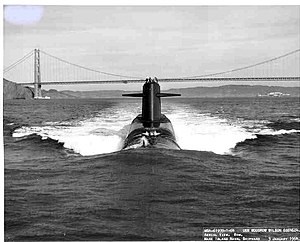41 for Freedom
 USS Woodrow Wilson, a Lafayette-class submarine that formed part of the "41 for Freedom" force
| |
| Class overview | |
|---|---|
| Name |
|
| Operators | |
| Preceded by | Regulus missile submarines |
| Succeeded by | Ohio class |
| Built | 1 November 1958 to 20 March 1965 |
| Completed | 41 |
| Active | 0 |
| Lost | 0 |
| Retired | 39 |
| Preserved | 2 |
| General characteristics | |
| Length | 381–425 ft (116–130 m) (depending on class)[1] |
| Beam | 33 feet (10 m)[1] |
| Draft | 31 feet (9.4 m)[1] |
| Speed | 20 knots (37 km/h; 23 mph)[1] |
| Test depth | In excess of 400 ft (120 m)[1] |
| Complement | 14 officers, 140 enlisted[1] |
| Armament |
|
41 for Freedom refers to the
SALT I Treaty limited the number of American submarine-launched ballistic missile tubes to 656, based on the total missile tubes of the forty-one submarines, in line with the treaty's goal of limiting strategic nuclear weapons to the number already existing.[3]
Overview
The United States had deployed nuclear weapons aboard submarines for the purpose of deterrence since 1959, using the
nuclear-powered ballistic missile submarines (SSBNs) were armed with submarine-launched ballistic missiles (SLBMs) to create a deterrent force against the threat of nuclear war with any foreign power threatening the United States during the Cold War
.
The US Navy created a new submarine classification for these boats: SSBN. The first of the "41 for Freedom" submarines to be completed was USS George Washington, which was commissioned on 30 December 1959. The final boat to enter service was USS Will Rogers, which was commissioned on 1 April 1967. The 41 submarines were ultimately superseded in service by the Ohio class, the first of which was commissioned in 1981.
SEAL platform in her later years, was decommissioned on 2 April 2002, the last boat of the original "41 for Freedom" submarines in commission, and the oldest submarine in the US Navy. Almost 37 years old, she held the record for the longest service lifetime of any nuclear-powered submarine. As of 2014, two boats, USS Daniel Webster and USS Sam Rayburn, though decommissioned, continue to serve as moored training ships, attached to Naval Nuclear Power School at Charleston, South Carolina
.
Submarines by Class
| Class | Completed | Retired | Preserved | In Commission | Polaris A1/A2 | Polaris A3 | Poseidon C3 | Trident C4 | ||||
|---|---|---|---|---|---|---|---|---|---|---|---|---|
| Yes/No | No. of boats |
Yes/No | No. of boats |
Yes/No | No. of boats |
Yes/No | No. of boats | |||||
| George Washington | 5 | 5 | 0 | 1959–1985 | 5 | 5 | 0 | 0 | ||||
| Ethan Allen | 5 | 5 | 0 | 1961–1992 | 5 | 5 | 0 | 0 | ||||
| Lafayette | 9 | 9 | 1* | 1963–1994 | 9 | 9 | 9 | 0 | ||||
| James Madison | 10 | 10 | 1* | 1964–1995 | 0 | 10 | 10 | 6 | ||||
| Benjamin Franklin | 12 | 12 | 0 | 1965–2002 | 0 | 12 | 12 | 6 | ||||
* Preserved as training vessels
Gallery
-
Weapons of the FBM submarines (left to right): Polaris A1, Polaris A2, Polaris A3, Poseidon, Trident I and Trident II
-
USS Halibut launches a Regulus missile – the limitations of the use of Regulus led to the development of the use of ballistic missiles from submarines.
-
A Polaris A3 missile is launched from USS Robert E. Lee. The advent of Polaris allowed for a virtually undetectable launching platform, as the submarine no longer needed to surface to launch its weapons
See also
References
- ^ a b c d e f Jane's Fighting Ships, 1971–72
- ^ Jane's Fighting Ships, 1985–86
- ^ "Nuclear-powered Ballistic Missile Submarines". Fast Attacks and Boomers: Submarines in the Cold War. National Museum of American History. 2000. Retrieved 30 January 2012.
External links
From the Federation of American Scientists:



